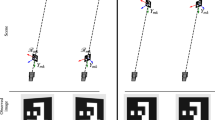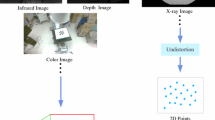Abstract
Purpose
C-arms are portable X-ray devices used to generate radiographic images in orthopedic surgical procedures. Evidence suggests that scouting images, which are used to aid in C-arm positioning, result in increased operation time and excess radiation exposure. C-arms are also primarily used qualitatively to view images, with limited quantitative functionality. Various techniques have been proposed to improve positioning, reduce radiation exposure, and provide quantitative measuring tools, all of which require accurate C-arm position tracking. While external stereo camera systems can be used for this purpose, they are typically considered too obtrusive. This paper therefore presents the development and verification of a low-profile, real-time C-arm base-tracking system using computer vision techniques.
Methods
The proposed tracking system, called OPTIX (On-board Position Tracking for Intraoperative X-rays), uses a single downward-facing camera mounted to the base of a C-arm. Relative motion tracking and absolute position recovery algorithms were implemented to track motion using the visual texture in operating room floors. The accuracy of the system was evaluated in a simulated operating room mounted on a real C-arm.
Results
The relative tracking algorithm measured relative translation position changes with errors of less than 0.75% of the total distance travelled, and orientation with errors below 5% of the cumulative rotation. With an error-correction step incorporated, OPTIX achieved C-arm repositioning with translation errors of less than \( 1.10 \pm 0.07 \) mm and rotation errors of less than \( 0.17 \pm 0.02^\circ \). A display based on the OPTIX measurements enabled consistent C-arm repositioning within 5 mm of a previously stored reference position.
Conclusion
The system achieved clinically relevant accuracies and could result in a reduced need for scout images when re-acquiring a previous position. We believe that, if implemented in an operating room, OPTIX has the potential to reduce both operating time and harmful radiation exposure to patients and surgical staff.














Similar content being viewed by others
References
Matthews F, Hoigne DJ, Weiser M, Wanner GA, Regazzoni P, Suhm N, Messmer P (2007) Navigating the fluoroscopeʼs C-arm back into position: an accurate and practicable solution to cut radiation and optimize intraoperative workflow. J Orthop Trauma 21:687–692. https://doi.org/10.1097/BOT.0b013e318158fd42
Suhm N, Müller P, Bopp U, Messmer P, Regazzoni P (2004) The MEPUC concept adapts the C-arm fluoroscope to image-guided surgery. Injury 35:120–123. https://doi.org/10.1016/j.injury.2004.05.020
Amiri S, Wilson DR, Masri BA, Anglin C (2014) A low-cost tracked C-arm (TC-arm) upgrade system for versatile quantitative intraoperative imaging. Int J Comput Assist Radiol Surg 9:695–711. https://doi.org/10.1007/s11548-013-0957-9
Esfandiari H, Amiri S, Lichti DD, Anglin C (2014) A fast, accurate and easy to implement method for pose recognition of an intramedullary nail using a tracked C-arm. Int Arch Photogramm Remote Sens Spat Inf Sci XL-5:217–223. https://doi.org/10.5194/isprsarchives-XL-5-217-2014
Tian W, Zeng C, An Y, Wang C, Liu Y, Li J (2017) Accuracy and postoperative assessment of pedicle screw placement during scoliosis surgery with computer-assisted navigation: a meta-analysis. Int J Med Robot 13:e1732. https://doi.org/10.1002/rcs.1732
Todesca A, Garro L, Penna M, Bejui-Hugues J (2017) Conventional versus computer-navigated TKA: a prospective randomized study. Knee Surg Sports Traumatol Arthrosc 25:1778–1783. https://doi.org/10.1007/s00167-016-4196-9
Rudolph T, Ebert L, Kowal J (2010) Comparison of three optical tracking systems in a complex navigation scenario. Comput Aided Surg 15:104–109. https://doi.org/10.3109/10929088.2010.530793
Yoo J, Schafer S, Uneri A, Otake Y, Khanna AJ, Siewerdsen JH (2013) An electromagnetic “Tracker-in-Table” configuration for X-ray fluoroscopy and cone-beam CT-guided surgery. Int J Comput Assist Radiol Surg 8:1–13. https://doi.org/10.1007/s11548-012-0744-z
Moult, E, Burdette EC, Song DY, Abolmaesumi P, Fichtinger G, Fallavollita P (2011) Automatic C-arm pose estimation via 2D/3D hybrid registration of a radiographic fiducial. In: Medical imaging 2011: visualization, image-guided procedures, and modeling, vol 7964. SPIE, pp 839–846. https://doi.org/10.1117/12.877713
Reaungamornrat S, Otake Y, Uneri A, Schafer S, Stayman JW, Zbijewski W, Mirota DJ, Yoo J, Nithiananthan S, Khanna AJ (2011) Tracker-on-C: a novel tracker configuration for image-guided therapy using a mobile C-arm. Comput Assist Radiol Surg Berl Ger 22–25
Wang L, Traub J, Heining SM, Benhimane S, Euler E, Graumann R, Navab N (2008) Long bone X-ray image stitching using camera augmented mobile C-arm. In: Metaxas D, Axel L, Fichtinger G, Székely G (eds) Medical image computing and computer-assisted intervention—MICCAI 2008. Springer, Berlin, pp 578–586
Touchette M (2017) Artificial X-ray imaging system (AXIS)—design and evaluation on c-arm performance in operating room and educational settings. (Masters thesis). University of British Columbia
Amini M (2016) A fluoroscopy-based intraoperative tool for measuring alignments in spinal deformity correction surgery (Masters thesis). University of British Columbia
Schwab F, Patel A, Ungar B, Farcy J-P, Lafage V (2010) Adult spinal deformity—postoperative standing imbalance: how much can you tolerate? An overview of key parameters in assessing alignment and planning corrective surgery. Spine 35:2224–2231. https://doi.org/10.1097/BRS.0b013e3181ee6bd4
Clavé A, Sauleau V, Cheval D, Williams T, Lefèvre C, Stindel E (2015) Can computer-assisted surgery help restore leg length and offset during THA? A continuous series of 321 cases. Orthop Traumatol Surg Res 101:791–795. https://doi.org/10.1016/j.otsr.2015.08.003
Zhang Z (2000) A flexible new technique for camera calibration. IEEE Trans Pattern Anal Mach Intell 22:1330–1334. https://doi.org/10.1109/34.888718
Esfandiari H, Lichti D, Anglin C (2017) Single-camera visual odometry to track a surgical X-ray C-arm base. Proc Inst Mech Eng [H] 231:1140–1151. https://doi.org/10.1177/0954411917735556
Tomasi C, Manduchi R (1998) Bilateral filtering for gray and color images. In: Sixth international conference on computer vision (IEEE Cat. No. 98CH36271). Narosa Publishing House, Bombay, India, pp 839–846
Hough PV (1962) Method and means for recognizing complex patterns. US3069654A
Canny J (1986) A computational approach to edge detection. IEEE Trans Pattern Anal Mach Intell PAMI 8:679–698. https://doi.org/10.1109/TPAMI.1986.4767851
Rublee E, Rabaud V, Konolige K, Bradski G (2011) ORB: an efficient alternative to SIFT or SURF. In: 2011 international conference on computer vision, pp 2564–2571
OpenCV Dev Team OpenCV documentation: feature. (Accessed 03 Nov 2019)
Lowe DG (2004) Distinctive image features from scale-invariant keypoints. Int J Comput Vis 60:91–110. https://doi.org/10.1023/B:VISI.0000029664.99615.94
Northern Digital Inc (2015) Optotrak Certus: technical specifications
Zatsiorsky VM (1998) Kinematics of human motion. Human Kinetics, Windsor
Acknowledgements
The authors would like to thank the following for their support: Centre for Hip Health and Mobility (CHHM), Institute for Computing, Information, and Cognitive Systems (ICICS).
Funding
This work was funded by the Natural Sciences and Engineering Research Council of Canada (NSERC) and by the Canadian Institutes of Health Research (CIHR) Collaborative Health Research Projects Program (Grant No. 462233-2014-CHRPJ).
Author information
Authors and Affiliations
Corresponding author
Ethics declarations
Conflict of interest
The authors declare that they have no conflict of interest related to this work.
Ethical approval
All procedures performed in studies involving human participants were in accordance with the ethical standards of the institutional and/or national research committee and with the 1964 Helsinki declaration and its later amendments or comparable ethical standards.
Human and animal rights
This article does not contain any studies with animals performed by any of the authors.
Informed consent
Informed consent was obtained from all individual participants included in the study. This article does not contain patient data. All evaluations were carried out by the authors.
Additional information
Publisher's Note
Springer Nature remains neutral with regard to jurisdictional claims in published maps and institutional affiliations.
Rights and permissions
About this article
Cite this article
Haliburton, L., Esfandiari, H., Guy, P. et al. A visual odometry base-tracking system for intraoperative C-arm guidance. Int J CARS 15, 1597–1609 (2020). https://doi.org/10.1007/s11548-020-02229-5
Received:
Accepted:
Published:
Issue Date:
DOI: https://doi.org/10.1007/s11548-020-02229-5




